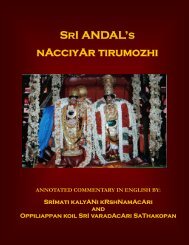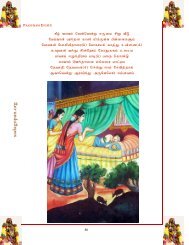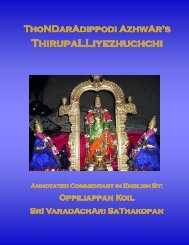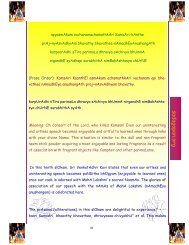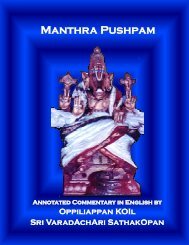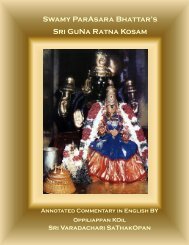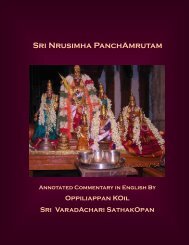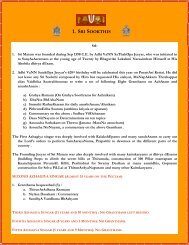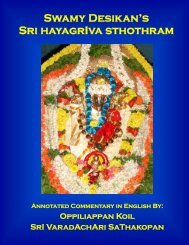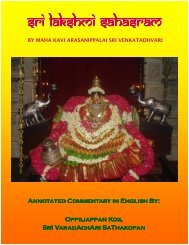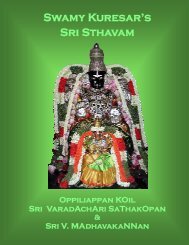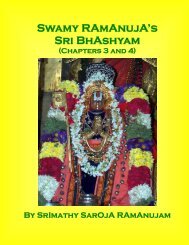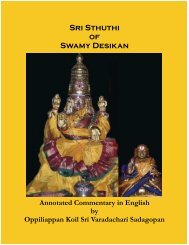Sri sudarshana vaibhavam Sri sudarshana ... - Sundarasimham
Sri sudarshana vaibhavam Sri sudarshana ... - Sundarasimham
Sri sudarshana vaibhavam Sri sudarshana ... - Sundarasimham
You also want an ePaper? Increase the reach of your titles
YUMPU automatically turns print PDFs into web optimized ePapers that Google loves.
. . ïI>.<br />
ïI>.<br />
<strong>Sri</strong> <strong>Sri</strong> <strong>sudarshana</strong> <strong>sudarshana</strong> <strong>vaibhavam</strong><br />
<strong>vaibhavam</strong><br />
Annotated Annotated Commentary Commentary in in English English By:<br />
By:<br />
Oppiliappan Oppiliappan Koil Koil<br />
Koil<br />
SrI SrI VaradAchAri VaradAchAri VaradAchAri SaThakopan<br />
SaThakopan<br />
1 &<br />
<strong>Sri</strong> <strong>Sri</strong> Anil Anil T T (Hyderabad)<br />
(Hyderabad)<br />
sadagopan.org<br />
sadagopan.org
sadagopan.org<br />
sadagopan.org<br />
. . ïI>.<br />
ïI>.<br />
SWAMY DESIKAN’S<br />
SHODASAYUDHAA STHOTHRAM<br />
ANNOTATED COMMENTARY IN ENGLISH BY:<br />
OPPILIAPPAN KOIL<br />
SRI VARADACHARI SATHAGOPAN<br />
2
CONTENTS<br />
<strong>Sri</strong> Shodhasayudha StOthram Introduction 5<br />
SlOkam 1 8<br />
SlOkam 2 9<br />
SlOkam 3 10<br />
SlOkam 4 11<br />
SlOkam 5 12<br />
SlOkam 6 13<br />
SlOkam 7 14<br />
SlOkam 8 15<br />
SlOkam 9 16<br />
SlOkam 10 17<br />
SlOkam 11 18<br />
SlOkam 12 19<br />
SlOkam 13 20<br />
SlOkam 14 21<br />
SlOkam 15 23<br />
SlOkam 16 24<br />
3<br />
sadagopan.org<br />
sadagopan.org
sadagopan.org<br />
sadagopan.org<br />
SlOkam 17 25<br />
SlOkam 18 26<br />
SlOkam 19 (Phala Sruti) 27<br />
Nigamanam 28<br />
<strong>Sri</strong> Sudarshana Kavacham 29 - 35<br />
<strong>Sri</strong> Sudarshana Vaibhavam 36 - 42<br />
( By Muralidhar Rangaswamy )<br />
<strong>Sri</strong> Sudarshana Homam 43 - 46<br />
<strong>Sri</strong> Sudarshana Sathakam Introduction 47 - 49<br />
Thiruvaymozhi 7.4 50 - 56<br />
SlOkam 1 58<br />
SlOkam 2 60<br />
SlOkam 3 61<br />
SlOkam 4 63<br />
SlOkam 5 65<br />
SlOkam 6 66<br />
SlOkam 7 68<br />
4
. . ïI>. ïI>.<br />
ïI>.<br />
ïImteingmaNt ïImteingmaNt mhadeizkay mhadeizkay nm><br />
nm><br />
. . ;aefzayuxStaeÇt!.<br />
;aefzayuxStaeÇt!.<br />
SWAMY DESIKAN’S<br />
SHODASAYUDHA STHOTHRAM<br />
Introduction<br />
Shodasa Ayutha means sixteen weapons of <strong>Sri</strong> Sudarsanaazhwar. This<br />
Sthothram is in praise of the glory of <strong>Sri</strong> Sudarsanaazhwar who is wielding<br />
sixteen weapons all of which are having a part of the power of the ChakrAudham<br />
bestowed upon them. This Sthothram consists of 19 slOkams.<br />
The first slOkam is an introduction and refers to the 16 weapons adorned<br />
by <strong>Sri</strong> Sudarsana BhagavAn. The 18 th slOkam is prayer to <strong>Sri</strong> Sudarsanaazhwar.<br />
The last SlOkam 19 is phala sruthi. SlOkam 2 to 17 (sixteen<br />
slOkams) are for each of the sixteen weapons.<br />
It is said that when Swamy Desikan was living at Kanchipuram, many people<br />
at Thirupputkuzi, about 5 miles from Kanchipuram were suffering<br />
from a wave of visha jvaram (cold fever), which was raging in an epidemic<br />
form. People were in distress. Swamy Desikan heard of this and he was<br />
very much moved by their suffering. Out of mercy for them, he composed<br />
this Sthothram and <strong>Sri</strong> SudarsanAshtakam, eulogizing <strong>Sri</strong> Sudarsana BhagavAn.<br />
Swamy advised the villagers to recite them. The rare form of <strong>Sri</strong><br />
5<br />
sadagopan.org<br />
sadagopan.org
sadagopan.org<br />
sadagopan.org<br />
Sudarsanar with 16 divine weapons responded to Swamy Desikan’s prayer<br />
immediately and banished the poisonous fever from the Dhivya desam.<br />
The visha jvaram was no match for the powerful weapons of <strong>Sri</strong> Sudarsana<br />
BhagavAn invoked by Swamy Desikan on behalf of the helpless people.<br />
This sthothram is in an unusual form. Swamy Desikan’s invocation is in<br />
the form of second person. Swamy says: “May He (<strong>Sri</strong> Sudarsanar) protect<br />
you!” in these slOkams. This explains why these two Sthothrams, find a<br />
place next to ParamArTa Sthuti, which is a Sthothram in praise of Thiruputkuzhi<br />
PerumaL, <strong>Sri</strong> VijayarAghavan.<br />
Swamy Desikan in the phala sruthi, says that he composed this Sthothram<br />
for the benefit and welfare of the pious and those who recite will be protected<br />
by <strong>Sri</strong> Sudarsanaazhwar<br />
The sixteen weapons of <strong>Sri</strong> Sudarsanaazhwar are: (1) Chakram (2) Axe -<br />
Parasu<br />
(3) Spear - kunta (4) Stick - Dhandam (5) angusam - goad (6) Sathamukhaagni<br />
- hundred edged weapon emitting Agni (7) Sword - Nistrimsa (8)<br />
Sakthi - vEl (9) Conch - Paanchajanyam (10) Bow- Saarngam (11) Noose -<br />
pAsam (12) Plough - Seera (13) VajrAyudham - Thunderbolt (14) Mace -<br />
Ghathai (15) Pestle - musalam (16) Trident - Soolam. These sixteen divine<br />
weapons can be seen on the archA moorthy of <strong>Sri</strong> Sudarsanaazhwar at<br />
Kanchipuram. Weapons 1 to 8 on are on the right hands from the top.<br />
Weapons 9 to 16 are on the left hands. These sixteen divine weapons are<br />
also mentioned in the last paasuram of Paramatha Bhangam. It is believed<br />
that by reciting these slokams, one can be free of diseases and live a<br />
healthy and happy life.<br />
6
Swami Desikan<br />
ïIman! ïIman! ïIman! ve»qnawayR> ve»qnawayR> kivtaik›kkesrI kivtaik›kkesrI ,<br />
,<br />
vedaNtacayRvyaeR vedaNtacayRvyaeR me me siÚxÄa< siÚxÄa< sda sda ùid ùid .<br />
.<br />
srImAn ve~nkaTanAthAryah kavitArkikakesarI |<br />
vEdAntAchArya varyO mE sannidhattAm sadA hrudi ||<br />
7<br />
sadagopan.org<br />
sadagopan.org
sadagopan.org<br />
sadagopan.org<br />
<strong>Sri</strong> Vijayavalli Sudarshanavalli samEtha <strong>Sri</strong> ChakrapANi PerumAL<br />
SLOKAM 1<br />
Sv Sv s»Lp s»Lp kla kla kLpErayuxErayuxeñr>,<br />
kLpErayuxErayuxeñr>,<br />
juò> juò> ;aefziÉRidVyEjRu;ta< ;aefziÉRidVyEjRu;ta< v> v> pr> pr> puman!. puman!. 1 1 .<br />
.<br />
sva sankalpa kalA kalpai: aayudhai: aayudhEsvara: |<br />
jushta: shoDasabhi: divyai: jushatam va: para: pumaan ||<br />
Meaning: SaasthrAs say that <strong>Sri</strong>man NaarAyaNan’s sanklapam (divine<br />
will) alone took the form of SudarsanAzhwAn. The small part of the<br />
sankalpam of Sudarsana BhagavAn transformed itself further into the sixteen<br />
weapons. May that ChakrarAjan (Sudarshanan) served by these sixteen<br />
aayudhams respond to your prayers for relief from the poisonous fever!<br />
8
SrI Keshava Moorthy Holding Four Chakrams<br />
SLOKAM 2<br />
ydayÄ< ydayÄ< jg½³< jg½³< kalc³< kalc³< c c zañtm!,<br />
zañtm!,<br />
patu patu vStTpr< vStTpr< c³< c³< c³ c³ êpSy êpSy ci³[>. ci³[>. 2 2 .<br />
.<br />
yadAyattam jagacchakram kAla chakram cha sAsvatam |<br />
pAtu vastatparam chakram chakra rUpasya chakriNa: ||<br />
Meaning: May the ChakrAyudham (one of the sixteen divine weapons)<br />
adorning the hands of ChaakratthAzhwAn protect you all! The Universe is<br />
rotating eternally driven by the tatthvam of Kaalam (second-minute-hourday-<br />
month-year). This Kaala tatthavm is under the control of the ChakrAyudham,<br />
which is the chief among the weapons of the Lord. He (The<br />
Lord) Himself takes on the form of this Chakram (Sudarsana Roopam).<br />
9<br />
sadagopan.org<br />
sadagopan.org
sadagopan.org<br />
sadagopan.org<br />
<strong>Sri</strong> Sudarshana at Thirumohur<br />
SLOKAM 3<br />
yTàsUit yTàsUit ztErasn! ztErasn! éÔa> éÔa> przulaÁDna>,<br />
przulaÁDna>,<br />
s s idVyae idVyae heitrajSy heitrajSy przu> przu> pirpatu pirpatu v>. v>. 3 3 .<br />
.<br />
yath prasUti sathai: aasan rudrA: parasu lAncchanA: |<br />
sa divyO heti rAjasya parasu: paripaatu va: ||<br />
Meaning: There are many RudrA ghanangals. The weapon for each one<br />
of them is axe (Parasu). These axes of the RudrAs were all progeny of SrI<br />
Sudarsanar’s Axe. RudrAs worship the Ayudharaajan (King of weapons),<br />
<strong>Sri</strong> SudarsanAzhvaan and get their axes from the Lord and do their duties.<br />
May <strong>Sri</strong> Sudarsana BhagavAn’s axe, which is the source for the creation of<br />
all other axes, protect you all!<br />
10
<strong>Sri</strong> Sudarshana at <strong>Sri</strong> Ranaganatha Temple, Pamona, NY<br />
SLOKAM 4<br />
helya helya heitrajen heitrajen heitrajen yiSmn! yiSmn! yiSmn! dETya> dETya> smud!x&te,<br />
smud!x&te,<br />
zk…Nta zk…Nta #v #v xaviNt xaviNt s s k…Nt> k…Nt> palyet palyet v>. v>. 4 4 .<br />
.<br />
hElayA hEti rAjEna yasmin daityA: samuddhrutE |<br />
sakuntA iva dhAvanti sa kunta: pAlayEta va: ||<br />
Meaning: When the Lord, Thiruvaazhiaazhvan playfully takes his spear<br />
(kunta:) on His hand, the asurAs will immediately run away helter-skelter,<br />
like a bird flying away swiftly (sakuntA iva dhAvanti). May that divine<br />
weapon “Spear” protect you all!<br />
11<br />
sadagopan.org<br />
sadagopan.org
sadagopan.org<br />
sadagopan.org<br />
<strong>Sri</strong> Sudarshana at Perumpuliyur<br />
SLOKAM 5<br />
dETy dETy danv danv muOyana< muOyana< muOyana< d{f(ana< d{f(ana< yen yen d{fnm!,<br />
d{fnm!,<br />
heit heit d{fez d{fez d{fae=saE d{fae=saE d{fae=saE Évta< Évta< d{fyed d{fyed iÖ;>. iÖ;>. 5 5 .<br />
.<br />
daitya dAnava mukhyAnAm daNDyAnAm yEna daNDanam |<br />
hEti daNDesa daNDa: asau bhavatAm daNDayEdh dvisSha: ||<br />
Meaning: DaithyAs were born to Diti. Daanavas were off spring of the<br />
race of demoness, Danu. Like this there are many asurAs. They are always<br />
intent in treating cruelly all Rishis and other pious people and giving trouble.<br />
Therefore, they deserve punishment. <strong>Sri</strong> Sudarsanar punishes them<br />
with His weapon “Stick” (Danda:). May Danda the divine weapon of the<br />
Lord, protect you all and destroy the enemies.<br />
12
SrI Sudarshana at Ahobila Matam<br />
SLOKAM 6<br />
AnNyaNvyÉ´ana< AnNyaNvyÉ´ana< éNxÚaza éNxÚaza mt¼jan!, mt¼jan!,<br />
mt¼jan!,<br />
An»…zivharae An»…zivharae v> v> patu patu hetIñra»…z>. hetIñra»…z>. 6.<br />
6.<br />
ananyAnvaya bhaktAnAm rundhan AasA matangajAn |<br />
anankusa vihArO va: paatu hetIsvara ankusa: ||<br />
Meaning: When BhakthAs who are totally devoted to Emperumaan and<br />
never even think of anya dEvathAs (ananyAnvaya) desire for worldly enjoyments,<br />
ThiruvaazhiaazhvAn will control them with His ankusam (goad)<br />
like an ankusam controlling the elephants. May this divine weapon<br />
“ankusam” with such an uninterrupted leelais protect you all!<br />
13<br />
sadagopan.org<br />
sadagopan.org
sadagopan.org<br />
sadagopan.org<br />
<strong>Sri</strong> Sudarshana at <strong>Sri</strong>rangam<br />
SLOKAM 7<br />
s. 7 7 .<br />
.<br />
sambhUya salabhAyantE yatra pApAni dEheenAm |<br />
sa paatu sata vaktrAgni hEtirhEtIsvarasya va: ||<br />
Meaning: One of the sixteen weapons of <strong>Sri</strong> Sudarsanaazhvaan is<br />
“Sathamukhaagni” (sata vaktra agni) which has hundred (100) mouths.<br />
Fierce fire is emitted through all these mouths. If mediated on this divine<br />
aayudham, all the sins of chEtanan will be destroyed like insects falling in<br />
to lamps and burnt. Such is the power of this aayudham. May this divine<br />
aayudham “agni” protect you all!<br />
14
<strong>Sri</strong> Sudarshana at ThiruKacchi<br />
SLOKAM 8<br />
Aiv*a< Aiv*a< Aiv*a< Svàkazen Svàkazen iv*aêpiZDniÄ iv*aêpiZDniÄ y>,<br />
y>,<br />
s s sudzRn sudzRn iniô iniô saEtu saEtu vStÅvdzRnm!. vStÅvdzRnm!. 8.<br />
8.<br />
avidhyAm sva prakAsEna vidhyArUpa: chinatthi ya: |<br />
sa sudarsana nistrimsa: sautu va: tatthva darsanam | |<br />
Meaning: Sword (nistrimsa:) is another divine weapon of <strong>Sri</strong> Sudarsanar.<br />
PuraNam says that this weapon is “Devathai” for jn~Anam. This weapon<br />
is the embodiment of jn~Anam (jn~Ana svaroopi). The very lustre of this<br />
divine weapon Sword can root out the ignorance (avidhya / ajJn~Anam).<br />
May this divine weapon “Sword” bestow upon you all tatthva jn~Anam<br />
(tatthva darsanam sautu)!<br />
15<br />
sadagopan.org<br />
sadagopan.org
sadagopan.org<br />
sadagopan.org<br />
<strong>Sri</strong> Sudarshana at Chakrapani Koil<br />
SLOKAM 9<br />
i³yazi´gu[ae i³yazi´gu[ae iv:[aeyaRe iv:[aeyaRe ÉvTyitzi´man!,<br />
ÉvTyitzi´man!,<br />
Ak…{Qzi´> Ak…{Qzi´> sa sa zi´rzi´< zi´rzi´< varyet varyet v>. v>. 9.<br />
9.<br />
kriyA sakti guNO vishNO: ya: bhavati atisaktimAn |<br />
akuNTha sakti: saa sakti: asaktim vArayEta va: ||<br />
Meaning: Yet one another of the sixteen weapon for ChaakratthAzhwAn is<br />
“Sakti” (vEl). This weapon is a very powerful one. It is said that the power<br />
to create the world (kriya sakti guna:) by EmperumAn is only due to this<br />
“Sakti” aayudham. The power (Sakti) of this weapon will never get diminished/blunted.<br />
(akunTha sakti:). May this weapon, “Sakti” destroy your<br />
asakti (inability, weakness)!<br />
16
<strong>Sri</strong> Sudarshana<br />
SLOKAM 10<br />
tarTv< tarTv< ySy ySy s àhr[eNÔSy àhr[eNÔSy paÂjNy> paÂjNy> s s patu patu v>. v>. 10 10 10 .<br />
.<br />
tAratvam yasya samsTaanE sabde cha paridrusyatE |<br />
prabhO: praharaNEndrasya paanchajanya: sa paatu va: ||<br />
Meaning: Next to <strong>Sri</strong> Sudarsanar, SrI Paanchajanyam the Conch is the<br />
most glorious and famed weapon of the Lord. The shape of this famed<br />
weapon is like that of “PraNavam” (Om). <strong>Sri</strong> Paanchajanyam is capable of<br />
making such a thunderous sound when blown, will cause the stomach of<br />
the enemies to tremble in great fear. May that <strong>Sri</strong> Paanchajanyam protect<br />
you all!<br />
17<br />
sadagopan.org<br />
sadagopan.org
sadagopan.org<br />
sadagopan.org<br />
SLOKAM 11<br />
y< y< saiTvkmh»arm! saiTvkmh»arm! AamnNTy]saykm!,<br />
AamnNTy]saykm!,<br />
AVyad AVyadœ AVyad ví³êpSy ví³êpSy tÏnu> tÏnu> za¼RxNvn>. za¼RxNvn>. 11.<br />
11.<br />
yam saatvikam ahankAram aamananti aksha saayakam |<br />
avyaadh va: chakra rUpasya taddhanu: sArnga dhanvana: ||<br />
Meaning: Maha Rishis says that Saathvika ahankAram is the divine<br />
weapon “Saarngam”, the bow and that the indhriyams arising out of such<br />
Satthvika ahankAram are the arrows. The Tiruvaazhiaazhvaan adorning<br />
the Emperumaan is but an Embodiment of Himself who bears the divine<br />
weapon Saarngam. May that Saarngam borne by the magnificent SrI Sudarsana<br />
protect you all!<br />
18
SLOKAM 12<br />
yuxeNÔe[ yuxeNÔe[ yenEv yenEv ivñsgaeR ivñsgaeR ivrCyte, ivrCyte,<br />
ivrCyte,<br />
s s v> v> saEdzRn> saEdzRn> k…yaRt! k…yaRt! paz> paz> paz> pazivmaecnm!. pazivmaecnm!. 12.<br />
12.<br />
aayudha indrENa yEna yEva visva sargO virachyatE |<br />
sa va: saudarsana: kuryAt pAsa: pAsavimochanam ||<br />
Meaning: Thiruvaazhiaazhvan creates the Universe with the<br />
“Noose” (Paasam) on HIS hand. May that divine weapon “Paasam” free<br />
you from the Samsaaric afflictions (paasam) and protect you all! BhagavAn<br />
by His sankalpam created this Universe. Thiruvaazhiaazhvan is the embodiment<br />
of the Lord Himself. It is therefore quite apt to say that <strong>Sri</strong> Sudarsanar<br />
created this Universe.<br />
Note the conflict on the use of the word of “Paasam”, which is used to<br />
bind as well to relieve the samsaara paasam.<br />
19<br />
sadagopan.org<br />
sadagopan.org
sadagopan.org<br />
sadagopan.org<br />
SLOKAM 13<br />
ivharae ivharae yen yen devSy devSy devSy ivñ]eÇk«;Ivl>,<br />
ivñ]eÇk«;Ivl>,<br />
VyJyte VyJyte ten ten sIre[ sIre[ nasIrivjyae=Stu nasIrivjyae=Stu v>. v>. 13.<br />
13.<br />
vihArO yEna dEvasya visva kshEtra krushIvala: |<br />
vyajyatE tEna sIrENa nAsIra vijayostu va: ||<br />
Meaning: The entire Universe is a cultivable land. Emperumaan is an<br />
incomparable former (uzhavan) of this Universe. The Lord cultivates the<br />
chEtanan, the land and gets the phalan out of this. Plough used for cultivating<br />
the agricultural land is yet another divine weapon borne by SrI Sudarsanar.<br />
This shows that HE is a peasant cultivating HIS Leelais. May<br />
the divine Plough bestow victory on the battlefront for all of you! (tEna sIrENa<br />
va:nasIra vijayOastu).<br />
20
“aayudhanAmaham vajram.........vasuki:” - Bhagavath Geeta: 10:28<br />
The divine power of <strong>Sri</strong> Sudarsanar’s Vajraayudham was transformed in to<br />
that of Indran. Due to this power only, Indran could kill the asuran and<br />
his Vajraayudham became famous. Unlike that of Indran’s weapon, the<br />
Lord’s weapon Vajraayudham was not created from the backbones of Rishi<br />
Dadheechi. Hence it is more famous. May this famed weapon protect you<br />
all!<br />
<strong>Sri</strong> Malolan<br />
21<br />
sadagopan.org<br />
sadagopan.org
sadagopan.org<br />
sadagopan.org<br />
SLOKAM 14<br />
Aayuxanamh< Aayuxanamh< v¿< v¿< #TygIyt #TygIyt y> y> s s v>,<br />
v>,<br />
AVyaÏetIzv¿ae=saE AVyaÏetIzv¿ae=saE AdxICyiSw AdxICyiSw s. s. 14.<br />
14.<br />
aayudhAnAm aham vajram iti agIyata ya: sa va: |<br />
avyAath hEtIsa vajroasau adadhIchyasTi sambhava: ||<br />
Meaning: Vajraayudham (Thunderbolt) is the weapon Indran. This<br />
weapon was created from the backbones of Rishi Dadheechi. Indra could<br />
kill the asuran Vriddhasuran, son of Diti, with this weapon. Among the<br />
weapons in the Universe, Vajraayudham is considered to be the foremost<br />
and best. When the Lord talks about the best of best things in Geeta, HE<br />
says that among the weapons, HE is Vajraayudham and HE is in all praise<br />
of this weapon.<br />
22
SLOKAM 15<br />
ivñ ivñ s saEdzRnI saEdzRnI ÉUyat! ÉUyat! gd gd gd àzmnI àzmnI gda. gda. . . 15.<br />
15.<br />
visva samhruti sakti: yaa visrutA buddhi rUpiNee |<br />
saa va: saudarsanI bhUyAt gada prasamnI gadA ||<br />
Meaning: The next divine weapon of the Lord is Gadhaa (Mace). Gadhaa<br />
is considered to be one of the tatthvam “Mahaan”. Mahaan is second<br />
in the order of the other tatthvams - Prakruthi, Mahaan, ahankAram.<br />
Saasthras praise the Lord’s weapon, Gadhaa as most powerful weapon capable<br />
of having the power to destroy the world (visva samhruti sakti:).<br />
May this weapon protect you and relieve you all your ailment!<br />
23<br />
sadagopan.org<br />
sadagopan.org
sadagopan.org<br />
sadagopan.org<br />
SLOKAM 16<br />
yaTyit]aed yaTyit]aed zailTv< zailTv< muslae muslae yen yen ten ten v>,<br />
v>,<br />
hetIz hetIz muslenazu muslenazu iÉ*ta< iÉ*ta< maehmaEslm!. maehmaEslm!. 16.<br />
16.<br />
yaatyati kshOda sAalitvam musalO yEna tEna va: |<br />
hEteesa musalEna aasu bhidyatAm moha mausalam ||<br />
Meaning: Musalam (Pestle) is another divine weapon of <strong>Sri</strong> Sudarsanaazhvaan.<br />
Due to the transformation of the power of this divine<br />
weapon in to other pestles of this Universe, this Lord’s weapon is capable<br />
of destroying every thing in this world. May this divine weapon remove<br />
quickly all your ignorance (ajJn~Anam) which is the main cause for all<br />
your troubles!<br />
24
SLOKAM 17<br />
zUil zUil zUil †ò †ò mnaevaRCyae mnaevaRCyae yen yen zUlyit zUlyit iÖ;>, iÖ;>,<br />
iÖ;>,<br />
Évta< Évta< ten ten Évtat! Évtat! iÇzUlen iÇzUlen ivzUlta. ivzUlta. 17.<br />
17.<br />
sooli drushta manOr vAchyO yEna soolayati dvisha: |<br />
bhavatAm tEna bhavatAt trisoolEna visoolataa ||<br />
Meaning: The Trident (Soolam) is the weapon of Sivan. Siva has revealed<br />
in ahirbudhnya SamhithA the powerful manthram of <strong>Sri</strong> Sudarsanar. Thiruvazhiaahvaan<br />
with his Soolam punishes the enemies. May the divine<br />
weapon “Soolam” protect you all and to live a healthy life with out any aiment<br />
(tEna trisoolEna bhavatAtam visoolataa)!<br />
25<br />
sadagopan.org<br />
sadagopan.org
sadagopan.org<br />
sadagopan.org<br />
SLOKAM 18<br />
Aô Aô Aô ¢amSy ¢amSy k«TõSy k«TõSy àsUit< àsUit< y< y< àc]te,<br />
àc]te,<br />
sae=Vyat! sae=Vyat! sudzRnae sudzRnae ivñm! ivñm! AayuxE> AayuxE> ;aefzayux>. ;aefzayux>. 18. 18.<br />
18.<br />
astra grAmasya krutsnasya prasUtim yam prachakshatE |<br />
sOavyAt sudarsanO visvam aayudhai: shODasAyudha: ||<br />
Meaning: May Lord Sudarsanan adorning all the sixteen divine weapons<br />
protect the entire Universe with them! He is indeed the origin of all the<br />
assembly of weapons in this world. SaasthrAs identify Him as the source<br />
kaaraNam for the entire assembly of weapons of the world.<br />
For additional thoughts on the <strong>vaibhavam</strong> of <strong>Sri</strong> Sudarsana BhagavAn,<br />
bhAgavathAs may refer to <strong>Sri</strong> SudarsanAshtakam on “<strong>Sundarasimham</strong>” Ebooks<br />
web site http://www.sundarasimham.org<br />
26
Swami Desikan on His Thirunakshatram at Thiruvaheendrapuram<br />
SLOKAM 19<br />
ïImÖe»qnawen ïImÖe»qnawen ïeyse ïeyse ÉUyse ÉUyse stam!,<br />
stam!,<br />
k«teymayuxeNÔSy k«teymayuxeNÔSy ;aefzayux ;aefzayux s. s. 19.<br />
19.<br />
srImad venkaTa nAaTEna srEyasE bhUyasE sataam |<br />
kruta iyam aayudha indrasya shoDasAyudha samstuti: ||<br />
Meaning: This sthothram on <strong>Sri</strong> SudarsanAzhvaan with sixteen divine<br />
weapons was composed by the poet known as <strong>Sri</strong> VenkatanaTan (Swamy<br />
Desikan) for the benefit and welfare of the pious people.<br />
27<br />
sadagopan.org<br />
sadagopan.org
sadagopan.org<br />
sadagopan.org<br />
kivtaikRkis
SUDARSHANA KAVACHAM<br />
It is customary to reach Jnanam thru the routes of Japa, Dhyana,<br />
Upasanaa and Yogam related to one's Ishta daivam. Top among the Mantras<br />
for such spiritual advancement is the Upasana of <strong>Sri</strong> Sudarsana Bhagavan<br />
known otherwise as Chakraraja. His Vaibhavam is celebrated in<br />
three major Stotrams, which have powerful sakthi to invoke Him. These<br />
are the Shadkam, Kavacham and Ashtakam by Swami Desikan. We will<br />
concentrate on the Kavacham to illustrate the esoteric meanings of<br />
29<br />
sadagopan.org<br />
sadagopan.org
sadagopan.org<br />
sadagopan.org<br />
Sudarsana Bhagavan.<br />
For this Sudarsana Kavacha MahA Manthram, (antharyAmi BhagavAn)<br />
SrIman NaarAyanan is the Rishi, Chandas is anushtup and the (Para)<br />
Devathai is SrIman NaarAyaNan Himself.<br />
For SrI Sudarsana Japa ViniyOgam, the Bheejam is "rum", the sakthi is<br />
"hum"; the keelakam is "PhaD". These aksharams used in SrI Sudarsana<br />
Japam pleases Lord ChakrarAjan.<br />
Sankham, Chakram, Gadhai, Sword and Padhmam/lotus on the hands of<br />
SrIman NaarAyaNan as well as the Musalam on the hand of Sudarshanar<br />
are<br />
some of the well known MudhrAs for this kavacham. Two more MudhrAs<br />
(DhEnu: and Yama Paasam) complete the list of the array of MudhrAs for<br />
the kavacham. Please learn them form dedicated upAsakAs of SrI Sudarsana<br />
BhagavAn.<br />
DhyAnam<br />
Sankham Saarngam sakhEDam hala-parasu-gadhA-<br />
kuntha-paasAn dhadhAnam ThvanyairvAmaischa<br />
chakrEshvasimusala-sdhavaja-soolAmkusaAgneen .<br />
JwAlA kesam kireetam Jwaladhanalanibham<br />
vahnimugrasthapeeDam prahtyAleedam<br />
thrinEthram ripu-gaNa-dhamanam<br />
bhAvayE ChakrarAjam<br />
The visualization of Lord Sudarsana is powerful here. Lord Sudarsana<br />
with His sixteen weapons on the sixteen hands, with flames shooting out<br />
of His hair, His incomparable radiance, His three eyes, His prathyAleeDam<br />
pose (with slightly bent and crossed legs in the posture of<br />
movement)on a peetam of Agni is visualized here.<br />
Lord SudarsanA's Sixteen weapons saluted in Swamy Desikan's ShOdasAyudha<br />
Sthothram are:<br />
(1) Chakram/Disc<br />
(2) Mazhu/Parasu/Axe<br />
(3) Eetti/spear/Kuntha:<br />
30
(4) ThaNDu/staff/DhaNDa:<br />
(5) Ankusam /Elephant goad<br />
(6) Agni roopa weapon/ with hundred faces/Satha vakthra agni hEthi:<br />
(7) Sword/Nisthrimsam<br />
(8) vEl/another kind of spear /Sakthi<br />
(9) Sankham/Conch<br />
(10) Bow/Saarngam<br />
(11) Paasam /Rope<br />
12) Kalappai/Plough/Seeram<br />
(13) Vajram/Weapon made of the back bone of a sage<br />
(14) Mace/Gadhai<br />
(15) Ulakkai/Pestle/Musalam<br />
(16) Soolam/Trident<br />
Number of these weapons have a Tatthvam behind them. For instance<br />
Gadhai is the mahath Tatthvam in the row of Prakruthi-MahAnahankAram.Saathvika<br />
ahankAram is recognized as the Bow. Some of these<br />
weapons are associated with individual gods (Sivan known for His Trident<br />
and Axe, Subramanyan for His Sakthi Aayudham and spear, Yama dharman<br />
for his paasam, Indhran for VajrAyudham).<br />
We will conclude this portion of the introduction to Sudarsana Kavacham<br />
here; Extensive prayers are included for the protection of the various limbs<br />
of the body (from head to foot), one's Jn~Anam, Japam, wealth, Courage ,<br />
Keerthi, Aayus/life, Strength, dangers from different directions, BhoothaprEtha-PaisAsa<br />
bheethi, Naaga dhOsham (Sarpa dhOsham), diseases and<br />
natural calamities .<br />
<strong>Sri</strong> Sudarshana Kavacham is a powerful kavacham which has number of<br />
passages relating to the special contextual relationship between Bhagavan<br />
Narasimhan and <strong>Sri</strong> Sudarsana Azhwaan.<br />
The Kavacham starts off majestically describing that relationship:<br />
Asya <strong>Sri</strong> Sudarsana Kavacha Mahaa Mantrasya,<br />
Bhagavaan Antharyaamii Narayana Rishi: Anushtub Chanda:<br />
<strong>Sri</strong> Sudarsana Roopi <strong>Sri</strong>man NaraayaNo Devathaa I Ram<br />
31<br />
sadagopan.org<br />
sadagopan.org
sadagopan.org<br />
sadagopan.org<br />
Bheejam ----- <strong>Sri</strong> Sudarsana Prasaadha siddhayrteh japeh viniyoga : II<br />
Sankham chakram gadhaa padmam musalam khadkameva cha I<br />
Dhanum cha yama Paasam cha MUDHRAA heyathaa: prakeerthithaa : II<br />
Paanchajanyayaaya Sankhaadhipateyeh Nama :I sudarsanaaya<br />
Hethi Raajaaya Nama : I --------- Yam Yamapaasaaya Nama : I<br />
Dhyaanam:<br />
Sankham saarngam sakhetam hala parasu<br />
gadhaa kuntha paasaan dhadhaanam<br />
tvanyairvaamayaisccha chakreshvasi musala<br />
lasadh vajra soolaankusaagneen I<br />
JWALAA KESAM kiritam JWALADHANILA NIBHAM<br />
VAHNIM UGRASTHA PEETAM<br />
PRATHYAALEETAM TRINETHRAM<br />
RIPUGANA DAMANAM BHAVAYETH CHAKRARAJAAM II<br />
THE ALTERNATIVE INVOCATION FOR THE KAVACHAM SHOWS<br />
THE CLOSE AFFILIATION WITH SWAMI DESIKAN'S REFERENCE<br />
TO AHIBUDHNYA IN HIS ASHTAKAM:<br />
BhajadhAHIRBUDHNYA LAKSHITA ! JAYA JAYA SRI SUDARSANA<br />
The second invocation preferred by some is more dramatic. I will cover it<br />
without inclusion of the Sudarsana Manthram:<br />
32
ANGA NYAASA KARA NYAASAM<br />
Om asya <strong>Sri</strong> Sudharsana kavacha stothra mahaamantrasya ,<br />
AHIRBUDHNYOH BHAGAVAAN RISHI : I Anushtubh chandha: I<br />
<strong>Sri</strong> Sudarsana MAHA NARASIMHO DEVATHAA I<br />
Sahasraaramithi bheejam I Sudarsanamithi Sakthi : I<br />
Chakramithi Keelakam I Mama Sarva Rakshaarteh<br />
SRI SUDARSANA PURUSHA SRI NRUSIMHA PREETHYARTEH<br />
Japeh Viniyoga : I Om Aachakraaya svahaa Angushtabhyaam Nama: I<br />
Om Vichakraaya svahaa tarjaneebhyaam Nama: I Om Suchakraaya<br />
svaaha Madhyamaabhyaam nama: I Om Suryachakraaya<br />
svahaa Anaamikhaabhyaam Nama: I Om Jwalaa chakraaya Svaahaa<br />
Kanishtikhaabhyaam Nama: I Om Sudarsana Chakraaya svaaha<br />
karatala Kara Prushtaabhyaam Nama: I Om Aachakraaya svaahaa<br />
hrudhayaaya Nama: I Om Vichakraaya svaahaa siraseh svaahaa I<br />
Om Suchakraaya Svaahaa sikhaayayai vashat I Om Surya Chakraaya<br />
svaahaa Bhalaaya kavachaaya hum I Om Jvaalaa chakraaya svaahaa<br />
nethraabhyaam voushat I Om Sudarsana Chakraaya svaahaa asthraaya PaT<br />
I<br />
Om Bhur bhuvasuvaromithi digh Bhandha : I<br />
DHYAANAM<br />
SANKAM CHAKRAM CHA CHAPAM PARASUMASIMISHUSOOLA<br />
PAASANKUSAASTHRAM<br />
BIBHRAANAM VAJRA KETOU HALA MUSALA GADHAA KUNTHA-<br />
MATYUGRA DHAMSHTRAM<br />
33<br />
sadagopan.org<br />
sadagopan.org
sadagopan.org<br />
sadagopan.org<br />
JWAALAA KESAM TRINETHRAM JWALADHANILA NIBHAM<br />
HAARA KEYURA BHOOSHAM<br />
DHYAAYETH SHATKONA SAMSTHAM SAKALA RIPU JANA<br />
PRAANA SAMHAARA CHAKRAM II<br />
MANTRAM FOLLOWS next - not included.<br />
56 SLOKAMS OF STOTHRAM FOLLOW THE MANTHRAM AND<br />
THE KAVACHAM CONCLUDES.<br />
The references to <strong>Sri</strong> Narasimha in the stotra sections are as follows:<br />
VEERASIMHO MUKHAM PAATHU---(SLOKAM 4)<br />
SUDARSANA NARASIMHO MEH SARIRAM PAATHU SARVADHAA -<br />
--(SLOKAM 13)<br />
BHAARYAAM LAKSHMI S AKHA: PAATHU<br />
PUTHRAAN PAATHU SUDARSANA; ---(SLOKAM 16)<br />
DIVAARTHROU CHA MAAM PAATHU<br />
AHIRBUDHNYA VARA PRADHA: ---(SLOKAM 18)<br />
The reference here is clearly to <strong>Sri</strong> Narasimha as the boon giver to Ahirbudhnya<br />
(Parama Sivan).<br />
The POWER of the Kavacham and Manthram of SUDARSANA NARAS-<br />
INHA IS INDICATED BY the following concluding sections of the Kavacham.<br />
34
VYAALA SARPAADHI SARVESHAAM VISHAAPAHARANAM PARAM<br />
I<br />
SAKALAM PRAAPNYAADHASYA KAVACHASYA PRASADHATA : I<br />
SHATKAARAANTHAMANIRDESYAM DIVYA MANTRENA SA-<br />
MYUTHAM I<br />
SRIYAM PRASANNA VADHANAM PRAPATHYEHAM SUDHAR-<br />
SANAM II<br />
35<br />
sadagopan.org<br />
sadagopan.org
sadagopan.org<br />
sadagopan.org<br />
Gopuram of <strong>Sri</strong> Chakrapani Koil , Kumbhakonam<br />
The only Temple dedicated to <strong>Sri</strong> Sudarshana<br />
Sudarsana Vaibhavam<br />
By<br />
SrI MuraLidhar Rangaswamy<br />
36
<strong>Sri</strong> Nrusimha Swamy on the backside of <strong>Sri</strong> Sudarshana at Kanchi<br />
The special relationship of Sudarsanar to Lord Narasimhan is also<br />
touched upon in the above section. A more elaborate description of the<br />
sambhnadham of Lord Narasimhan to ChakrarAjan is covered by SrI MuraLi<br />
Rangaswamy in an artcile that appeared in SaranAgathy Journal.<br />
Namaschakraya vidhmahe Sahasra JwAlaya Dheemahe<br />
ThannO Sudarshana PrachOdayAt<br />
37<br />
sadagopan.org<br />
sadagopan.org
sadagopan.org<br />
sadagopan.org<br />
"Ugram Veeram Mahavishnum Jwalantam Sarvatomukham I Nrusimham<br />
Bheeshanam Bhadram Mrutyumrutyam NamAmyaham II", provdies eloquent<br />
testimony to this fact. Lord Narasimha destroyed Hiranyakashipu in<br />
the form of JwAlA Narasimha bringing instant relief (Pida Pariharam) to<br />
Prahlada from his sufferings. Therefore, Lord Narasimha is considered to<br />
be resident in the Chakram. The presence of the Sudarsana Chakram in<br />
the nails of Bhagavan Narasimha is indicated again by Ahirbudhnyan in<br />
the Mantra Raaja Pada Stotram in the salutation "NakhAgrE Shakalee<br />
ChakrE". Sudarsana and Lord Narasimha share deep rooted and intimate<br />
connections. The joint worship of Sudarsana-Narasimha is prescribed by<br />
both PaancharAtra and VaighAnasa Agamams.<br />
The Padma Samhita reports the presence of Lord Narasimha with sixteen<br />
arms in the Sudarsana Yantram. Swami Desikan glorifies the ShodasAyudha<br />
(sixteeen arms of Sudarsana, each bearing a potent weapon) aspect<br />
of the Sudarsana Chakram in the ShodasAyudha Stotram. These references<br />
point to the common features of the back-to-back forms of Sudarsana<br />
and Narasimha. The back-to-back forms of Sudarsana Narasimhar<br />
are seen in a single Peetam at the <strong>Sri</strong>rangam Temple (ChakrathAzhwAr<br />
Sannidhi). Sudarsana-Narasimha SaaLagramam provides further testimony<br />
to the worship of this form of Lord Narasimhar.<br />
The Chakram is also the abode of the four Vyuha Murthis: Vasudeva,<br />
Sankarshana, Pradhyumna and Aniruddha. This is reflected in Swami Desikan's<br />
Sudarsana Ashtakam salutation: Nija Para Vyuha Vaibhava. The<br />
geometric form of the Sudarsana Yantram consists of six corners formed<br />
by two intersecting triangles circumscribed in a circle. The Vyuha Murthis<br />
find their abodes around the corners of the Sudarsana Chakram. Starting<br />
from the top right hand corner of the Chakram, the six vertices correspond<br />
to "A Chakram", "Vi Chakram", "Su Chakram", "Surya Chakram",<br />
"Jwala Chakram" and "Sahasrara Charkam", respectively. The Sudarsana<br />
Chakram itself is at the center of the Yantram along with Lord Narasimha.<br />
Therefore, offering prayers to the Sudarsana Chakram is equivalent to saluting<br />
Lord Narayana in Para, Vyuha, Vibhava, Archa and AntharyAmi<br />
forms. The glorification of the Lord in the Chakram form can also be<br />
found in the ShodasAyudha stotram (Chakra Rupasya ChakriNaha).<br />
"A Chakram" arises from the relationship of the sound "A" to Lord<br />
38
Sudarsana Chakram is the mighty weapon of Lord Narayana. The term<br />
Sudarsana means that which is beautiful to behold. The beauty of the Sudarsana<br />
Chakram arises from the fact that the Chakram leads the seeker to<br />
the path of Lord Narayana. The Chakram has many auspicious attributes.<br />
The foremost amongst these attributes is Peeta Pariharam (relief from all<br />
kinds of pain and suffering) for the devout and Peeta Pradanam (relentless<br />
misery) for the evil minded. The Sudarsana Chakram also has the characteristic<br />
of Papa NAsanam (destroying one's sins). Papa NAsanam is the<br />
first step towards realizing Lord Narayana.<br />
The magnificence of the Sudarsana Chakram is very eloquently described<br />
by Swami Desikan in both the ShodasAyudha Stotram and the Sudarsana<br />
Ashtakam. Related references which offer tributes to the Chakram include<br />
the Mahabharata, Vishnu Sahasranamam, Padma Samhita and Ahirbudhnya<br />
Samhita (both of which are PaancharAtra Agama texts), Sudarsana<br />
Kavacham, and <strong>Sri</strong>mad Bhagavatam. In addition, several Azhwars<br />
have paid tributes to the Chakram in their Pasurams (cf:Tirumazhisai<br />
Azhwar, Nammazhwar, Periya Azhwar and Tirumangai Azhwar).<br />
The Chakram transcends space and time. This is seen from Swami Desikan's<br />
Shodasayudha stotram salutation Jagat Chakram Kala Chakram Cha.<br />
Therefore, the Chakram is an Amsham of Para Vasudeva. The Mahabharata<br />
refers to the wheel of time (Kala Chakram), denoting the temporal<br />
aspect of the Sudarsana Chakram. The Vishnu Sahasranamam salutation<br />
"Ritu Sudarsana Kala Iti Digbandha:" also refers to the spatio-temporal<br />
aspects of the Chakram. The Chakram is the mighty jwala which forms<br />
the center of the Kalanala (fire at the end of time).<br />
This Jwala has the radiance of a thousand suns which is evident from the<br />
opening salutation of the Sudarshana Kavacham. Sahasraditya Sankasham,<br />
Sahasra Vadanam Param Sahasradam SahasrAram Prapadyeham Sudarsanam.<br />
Therefore, the Chakram dispels all ignorance and darkness.<br />
The mighty Jwala also connotes the JwAlA Narasimhar aspect. The opening<br />
salutation of the Mantrarajapada Stotram of the Ahirbudhnya Samhita,<br />
39<br />
sadagopan.org<br />
sadagopan.org
sadagopan.org<br />
sadagopan.org<br />
Vishnu. "A" is the first syllable of PraNavam (AUM) which is associated<br />
with Lord Narayana from the vedic salutation: AkAra UkAra MakAra Iti.<br />
Furthermore, ThiruppAn Azhwar's Amalanatipiran, Swami Desikan's<br />
Bhagavad Dhyana Sobanam and Munivahana Bhogam, and Narayana<br />
Bhattadripad's NarayaNeeyam commence with the syllable "A". These<br />
facts may be used to infer that "A" is VishNoraksharam.<br />
"Vi Chakram" denotes the Akshara Vi, which is the starting Aksharam of<br />
Lord VishNu's name. Parashara Bhattar, in his VishNu Sahasranamam<br />
commentary, expounds on VishNu as: CharAchara Bhuteshu VeshaNAth<br />
Iti VishNu: Uchyathe (that which enters the sentinent and insentinent beings<br />
is called Vishnu). The Vi Chakram symbolizes this aspect of Lord<br />
VishNu.<br />
"Su Chakram" denotes the abode of all auspicous attributes, i.e., the Kalyana<br />
GuNams of JnAna Bala, Aishwarya, Shakti, Tejas, and Vatsalya. This<br />
aspect of the Sudarsana Yantram is inferred from Swami Desikan's Sudarsana<br />
Ashtakam salutation: Nirupatsipeeta Shad GuNa. Due to the synergy<br />
between the Chakram and Lord Narayana, one is led to wonder whether<br />
the Lord's right hand is beautiful on account of being adorned by the Sudarsana<br />
Chakram or whether the touch of the Lord's hand imparts added<br />
beauty and effulgence to the Chakram.<br />
"Surya Chakram" refers to the fact that the radiance of Sudarsana exceeds<br />
that of a thousand Adityas. Testimony in support of this fact is seen in the<br />
opening salutation of the Sudarsana Kavacham, Ambarisha's Prapatti Stotram,<br />
and the PanchAyudha stotram salutation: Sudarsanam Bhaskara Koti<br />
Tulyam.<br />
"Jwala Chakram" refers to the spatial aspect of the Sudarsana Chakram<br />
and the association with KaalAnala, while the "Sahasrara Chakram" derives<br />
its name from the BijAksharAm for Sudarsana which is contained in<br />
the Sudarsana Kavacham.<br />
Further references attesting to the greatness and auspicious attributes of<br />
40
the Sudarsana Chakram can be found in the Sudarsana Ashtakam of<br />
Swami Desikan. Vedic tributes to the Sudarsana Chakram can be seen<br />
from the salutation "Shatamaka Brahma Vandita Shatapata Brahma Nandita."<br />
Great scholars seek the help of Sudarsana before engaging in debates<br />
(Pratita Vidvatsa pakshita). In the Ahirbudhnya Samhita, Ahirbudhnya<br />
(Siva) desires to see the glorious form of the Chakram (Bhajata<br />
Ahirbudhnya Lakshita). Great scholars stumble in their attempts to discern<br />
the vast extent of the Chakram's glory (Parijana ThraNa Pandita). The<br />
Chakram is the protector of the Devas, the destroyer of the Asuras and is<br />
the bestower of true knowledge, while tearing to shreds all pretence of<br />
false knowledge. This is seen from the passage: Dhanujavistara Kartana<br />
Janitamisravikartana Dhanuja Vidya Nikartana Bhajata Vidya Nivartana.<br />
Amara Drushtasva Vikrama Samarajushta Bramikrama. This is interpreted<br />
as the Chakram being the destroyer of Tamo Guna and enhancing or protecting<br />
Satva Guna. The Chakram is also the eye of the universe, the three<br />
Vedas and the three sacrifical fires as can be seen from: Bhuvana NEthra<br />
Trayeemaya Savana Teja Trayeemaya Niravadisvatu Chinmaya Nikila<br />
ShaktE Jaganmaya.<br />
All aspects of Yajna are embodied by Yajna Varaha Swamy. The Vishnu Sahasranamam<br />
salutations 971-982 establish the Yajna aspects of Lord Narayana.<br />
These tributes in conjunction with Swami Desikan's eulogy may be<br />
used to establish connections between the Sudarsana Chakram and Yajna<br />
Varaha Swamy.<br />
The Chakram unfailingly comes to the rescue of the Lord's devotees as<br />
seen from the following instances:<br />
*The relentless pursuit of Durvasa, who tried to kill Ambarisha with his<br />
fiendish creation (cf: <strong>Sri</strong>mad Bhagavatam).<br />
*The destruction of Sisupala, when he offended Yudhishtira and Bhishma<br />
(cf: Mahabharata).<br />
*Arjuna was able to kill Jayadratha despite great odds only on account of<br />
the Chakram masking the Sun (cf:Mahabharata).<br />
41<br />
sadagopan.org<br />
sadagopan.org
sadagopan.org<br />
sadagopan.org<br />
*In the Vamana Avataram, the blade of grass used to clear the opening of<br />
the jar (which had been blocked by SukrAcharya) containing water for Mahabali's<br />
Sankalpam (cf: Kalakshepam of <strong>Sri</strong> <strong>Sri</strong>vatsankachariar Swamigal).<br />
The Chakram confers Moksham to anyone who surrenders to it as well as<br />
anyone killed by it. Examples of people attaining Moksham by being<br />
killed by the Chakram are: Shishupala, NarakAsura, Poundra VasudEva<br />
and the crocodile in Gajendra Moksham. Ambarisha is an example of a<br />
devout person who was protected by the Chakram and ultimately graced<br />
by the Lord.<br />
The Chakram also has the power of healing and curing illness. It is believed<br />
that Tirupputkuzhi village was suffering greatly from an epidemic<br />
fever. The residents of the village requested Swami Desikan for help. Accordingly,<br />
Swami Desikan composed the Sudarsana Ashtakam bringing<br />
instant relief from the epidemic. Also, the Sudarsana Homam has the<br />
power of curing people under the possession of the mighty Brahma Rakshasa.<br />
In conclusion, performance of Sudarsana Homam confers health, wealth<br />
and prosperity on the seeker. If one desires material benefit, the Chakram<br />
grants him all the riches he wants. If the seeker desires spiritual benefit, he<br />
begets this upon performance of the Homam. Suddam (cleanliness) is of<br />
utmost importance in the worship of Sudarsana Chakram. Therefore, the<br />
Homam must be performed with great regard to the Deha (body), Manas<br />
(mind) and Sthana (place) Suddam. Purity of thought, sound and intonation<br />
while chanting the Homa mantrams gives sampurna phalam (benefit<br />
to the utmost extent).<br />
Sankha Chakra GadApaNE Dwaraka NilayAchyuta<br />
Govinda PundarIkAksha RakshamAm SaraNAgatham<br />
SahasrakshAya VithmahE Shata YajnAya Dheemahe<br />
Tanno Sudarsana Prachodayat<br />
42
<strong>Sri</strong> Sudarshana Homam<br />
SHRI MAHA SUDARSHAN HOMAM<br />
SrI Sudarsana Homam is a powerful and grand homam consisting of the<br />
recitation of many Veda manthrams preceded by BhIjAksharams and<br />
prayOgams.<br />
A brief sequence for Sudarsana Homam acording to one sampradhAyam<br />
is as follows:<br />
1. Sudarsana Manthra Japam with kara nyAsam , HrudhayAdhi nyAsam ,<br />
DhyAanam , ViniyOgam<br />
2. Sudarsana AshTottharam starting with (PraNavam) SudarsanAya nama:<br />
and concluding with (PraNavm) NaarAyaNakrupAvyUha tEjascchakrAya<br />
nama:<br />
3. SrI Sudarsana Homa MahA Sankalpam<br />
43<br />
sadagopan.org<br />
sadagopan.org
sadagopan.org<br />
sadagopan.org<br />
4. Kumba AavAhanam: In that Kumbam , VaruNan , Lakshmi NaarAya-<br />
Nan,<br />
Sudarsan are invoked and ShOdasOpachAra AarAdhanam is performed<br />
5. Agni Prathishtai<br />
6. Homam with the following Manthrams:<br />
** SrI Sudarsana ShadAkshari (108 times) with aahUthi<br />
** SrI Sudarsana GaayathrI<br />
** SrI Sudarsana MaalA Manthram<br />
** SrI Nrusimha manthram<br />
** SrI Nrusimha GaayathrI<br />
** SrI VishNu GaayathrI<br />
** SrI LakshmI GaayathrI<br />
** SrI LakshmiI Manthra Homam<br />
** SrI DhanvanthrIi Manthra prayOgam<br />
** SrI Paanchajanya Gaayathri<br />
** PoorNAhUthi<br />
All (the Four participants)/rhtviks) and the spectators go around the Agni<br />
Kuntam and recite SrI SudarsanAshtakam. The Basmam (saampal) from<br />
the Homam is worn on the forehead for auspiciousness and protection.<br />
The Homam concludes here.<br />
In this Homam, if Lord Sudarsana is pleased, you may get a glimpse of<br />
Sudarsana BhagavAn in the Saptha jihvA (Seven tongued) of Agni JwAlai.<br />
Optional: Sudarsana ShaDkam can be recited here followed by<br />
44
SrI Sudarsana Sathakam of <strong>Sri</strong> Koora NaarAyaNa Jeeyar. This is a powerful<br />
sthOthram.<br />
This sthOthram is about the fierce and yet auspicious Sudarsana JwAlai<br />
and the other parts of Sudarsana Chakram. SrI Koora NaarAyaNa Jeeyar<br />
has blessed us with 100 slOkams on Lord Sudarsana (24 on the Sudarsana<br />
JwAlai, 14 on the nEmi of SudarsanA , 12 on the arams of SudarsanA , 11<br />
slOkams on the Naabhi of Sudarsana chakram, 13 slOkams on the Aksham<br />
of the Chakram and 26 on the description and salutation of Sudarsana<br />
MahA Purushan presiding over this MahA Chakram).<br />
In conclusion, Swamy NammAzhwAr's ThriuvAimozhi decad 7.4 can be<br />
recited for general auspiciousness and to ward off any amangalams.<br />
This decad starts with the Paasuram:<br />
Aazhiyezha Sankum villumzha , disai<br />
vaazhiyezhat-taNDum VaaLUmezha , aNDam<br />
mOzhaiyeazha mudipaadhamezha , Appan<br />
Oozhyezha Ulaham koNDavARE<br />
Invocatory benedictions<br />
*********************<br />
1.SoudarsanI JwAlA BhavathAm abhIpsithAni vitharathu!<br />
(May the most beautiful to behold JwAlai of Sudarsanar grant You all what<br />
You desire).<br />
2.chAkram maha: BhUtayE va: sphurathu !<br />
(May the Tejas/Radiance of Sudarsana BhagavAn remove all kinds of<br />
poverty and grant great wealth).<br />
3. JyOthi BhavathAm praharsham pradisathu!<br />
(May the effulgence of SrI Sudarsanar remove all worries and grant you<br />
happiness).<br />
4-100: There are similar benedictions that go with every slOkam of SrI Su-<br />
45<br />
sadagopan.org<br />
sadagopan.org
sadagopan.org<br />
sadagopan.org<br />
darsana Sathakam to give us an understanding of the MahA MangaLams<br />
arising from SrI Sudarsana manthra japam, Homa Karyam and SthOthra<br />
Padanam.<br />
Maha Sudarshana Homam<br />
46
SrI:<br />
Jaya Jaya SrI Sudarsana !<br />
<strong>Sri</strong> Maha Vishnu with His Sudarshanam<br />
SRI SUDARSANA SATHAKAM<br />
Let us invoke <strong>Sri</strong> Sudarsana Bhagavaan and start with the Taniyan for SrI<br />
Koora NaarAyana Jeeyar, the author of this powerful sthOthram:<br />
RangEsa vij~napthi karAmayasya<br />
chakAra ChakrEsanuthim nivrutthayE<br />
SamAsrayEham varapooraNIm ya:<br />
Tamm Koora-NaarAyana nAmakam munim<br />
47<br />
sadagopan.org<br />
sadagopan.org
sadagopan.org<br />
sadagopan.org<br />
Meaning: adiyEn seeks the refuge of SrI Koora NaarAyana Jeeyar , who<br />
composed the Sudarsana sathakam , which fulfills all wishes. This<br />
SthOthra grantham about SrI Sudarsna BhagavAn cured the illness of Thiruvaranga<br />
PerumAL arayar.<br />
Special Notes:<br />
Thiruvaranga PerumAL arayar is one of the five AchAryAs of EmperumAnAr.<br />
At one time, he was unable to perform his regular Kaimkaryam to<br />
Lord RanganAtha. SrI Koora NaarAyaNa Jeeyar was a direct disciple of<br />
AchArya RaamAnuja just as KurEsar from the same village of Kooram<br />
was. KurEsar used to tease Koora NaarAyaNa Jeeyar about the need for<br />
any manthram other than AshtAkshari for a Prapannan. Koora NaarAyaNa<br />
Jeeyar used to respond with the statement that Sudarsana Manthram will<br />
have a role to play at the right time.<br />
When Thiruvaranga perumAL Arayar fell ill and was incapacitated, then<br />
KurEsar (SrIvathsAnga Misrar) came running to Koora NaarAyana Jeeyar<br />
and asked him to intervene with Sudarsana Manthram to help Arayar.<br />
Koora NaarAyana Jeeyar composed this Sathakam and prayed to Lord Sudarsana<br />
with the help of VaidhikAs at the famous Sannidhi of Lord Sudarsana<br />
at SrIrangam temple. Lo and Behold ! Arayar Swamy was cured of his<br />
incapacitating illness and resumed his interrupted Kaimkaryam to the<br />
Lord. Such is the power of this Sathakam!<br />
Before we get into the Text of the 100 slOkams of SrI Sudarsana<br />
sathakam, it is customary to recite Swamy NammAzhwAr"s ThiruvAimozhi<br />
decad: 7.4. adiyEn will translate those eleven Paasurams next for<br />
auspiciousness on the readers and the writer for kaimkarya Poorthi without<br />
vignam. Please recite these eleven paasurams for success in all of your<br />
endeavors !<br />
This decad is very auspicious for those who are facing a lot of difficulties<br />
in life. These paasurams have been recited for overcoming many of the<br />
life's inauspiciousness, big & small. It is customary to recite them before<br />
SrI Sudarsana sathakam slOkams.<br />
48
Prior to exploring the meanings of these pAsurams , let us see the context<br />
of this decad.<br />
In the previous decad , ParAnkusa Naayaki expressed her intense desire to<br />
visit her Lord at ThirupEryail dhivya Desam .In the last paasuram of that<br />
previous decad , Swamy NammAzhwAr stated that those , who recite these<br />
ten paasurams dealing with the lord of ThiruppEryeil with MahA Sudarsanam<br />
in His upper right hand would be blessed with noble Kaimkarya SrI<br />
like SudarsanAzhwAr Himself.<br />
At the thought of the Lord with Sudarsanam on His hand, ParAnkusa<br />
Naayaki was blessed with the vision of the Lord returning from His Vijaya<br />
YaathrA adorning all His aaydhams such as Chakram, Conch, Bow, Mace<br />
and Sword .Paraankusa Naayaki's viraha Taapam and worries were all banished<br />
and out of the joy of the Lord's sevai, she blessed us with these ten<br />
paasurams. PerumAL's Vijaya <strong>Sri</strong> is celebrated along with the Kaimkarya<br />
SrI of all the weapons headed by SudarsanAzhwAn.Nanjeeyar has commented<br />
on the purport of these paasurams this way:<br />
" virahatthAl vantha taLarcchi theertthu midukkuNDAm-padiyAha<br />
--Tannudaya vijayangalai EmperumAn Kaati aruLak-kaNDu dharittha<br />
AzhwAr---yEtthi iniyanAnAr".<br />
AzhwAr's weakness and sorrow arising from separation from His Lord<br />
were banished and he felt fulfilled over the sevai of the Lord returning<br />
from His Vijaya YaathrAs. AzhwAr sang about this victorious Lord and became<br />
filled with a sweet and delectable experience. AzhwAr starts with the<br />
visualization of ThrivikramAvathaaram (Ongi UlahaLantha Utthman's<br />
avathAram and conquest on Earth & sky).<br />
Swamy Nammalwar<br />
49<br />
sadagopan.org<br />
sadagopan.org
sadagopan.org<br />
sadagopan.org<br />
ThiruvAi Mozhi (TVM): 7.4.1<br />
*************************<br />
Azhiyezhac-changumum villumezhat-tisai<br />
vAzhi yezha taNDum VaaLumezha, anDam<br />
mozhai yezhamudi paadham yezha, Appan<br />
Oozhi yezha ulaham koNDavArE<br />
Oh Lord ! Hail to Thy Victory over MahA Bali! When You recieved the arghya<br />
jalam to solemnize the gift of three feet of land from MahA Bali, You<br />
grew to a gigantic ThrivikramA form . Your weapons hurried and got in to<br />
their wonted sthAnams and rushed as it were to protect You and grew in<br />
proportion to Your growing ThirumEni. The first of the Lord's weapons to<br />
report to duty was Hethi RaajA, the Sudarsanam .The Sankham<br />
(Paanchajanyam), the bow (Saarngam), the Mace (KoumEthaki) and the<br />
Sword (Nandhakam) followed the Chakra Raajan and grew in proportion<br />
to Your growing body. They were ready to engage in fight to protect You<br />
in the event of any danger that might come Your way. Your headadorning<br />
the crown rose and pierced the wall of aNDam. Your Sacred feet now grew<br />
and got past Your crown. The big toe of Your left foot was instrumental in<br />
piercing the wall of aNDam and aavaraNa jalam flooded in and mixed<br />
with Gangai that had risen earlier from the KamaNDalu Jalam used by<br />
BrahmA as Paadhyam to wash Your feet as it shot past Sathya Lokam , the<br />
residence of Your son.<br />
AzhwAr has the adhbhutha sEvai of ThrivikramAvathAram here and celebrates<br />
this and exclaims: What a great victory by the Lord engaged in returning<br />
the Earth from MahA Bali, who had taken it away from the DevAs<br />
by force !<br />
ThiruvAi Mozhi (TVM): 7.4.2<br />
*************************<br />
Next, the Lord's KoormAvathAram and churning of the Milky ocean for<br />
nectar (amrutha maTanam) is seen by Swamy NammAzhwAr. He sings<br />
about that Vijaya Yaathrai that he was blessed to witness:<br />
50
aaRu-malaikkedinthOdum oli ara-<br />
vooRu sulAi malaittEykkum oli kadal<br />
mARu suzhanRu azhaikkinRa oli Appan ,<br />
sARu pada amudham koNDa nAnRE<br />
During amrutha maTanam, the vehemence of the churning made all the<br />
rivers reverse their direction of flow, the ocean heaved and the ear shattering<br />
sound of the churning with the rope of Vaasuki wrapped around the<br />
mountain of Mandara spread all around. My Lord took such an effort to<br />
hold the rope of Vaasuki in His own hands and made such a gigantic effort<br />
to churn the milky ocean to release the nectar for the benefit of the<br />
DevAs.I was blessed to witness this sight of the Lord at work. What a great<br />
service He performed for His aasritha janams and what a gigantic victory<br />
He scored on that day !<br />
ThiruvAi Mozhi (TVM): 7.4.3<br />
*************************<br />
The Varaha avathAram is brought next before the eyes of Swamy NammazhwAr<br />
by the Lord.This is another rakshaNa leelai performed for rescuing<br />
His divine consort, BhUmi PirAtti.<br />
nAnrila yEzh maNNum tAnatthavE oinnum<br />
nAniRla yEzh malai tAnatthavE pinnum<br />
nAnRila yEzh kadal tAnatthavE Appan<br />
oonRi idhanthu yeyiRRil koNDa nALE<br />
What a miracle my Lord performed during His incarnation as the gigantic<br />
Varaham! My Lord dived to the bottom of the praLaya jalam and lifted His<br />
Devi from there and placed Her on His long Tusk. While doing this, He<br />
made sure that the seven Kula parvathams, the seven oceans, the seven<br />
dhveepams did not slacken from their original places. Ever so carefully and<br />
skillfully, He lifted His Devi without disturbing these land marks. What a<br />
glorious feat!<br />
51<br />
sadagopan.org<br />
sadagopan.org
sadagopan.org<br />
sadagopan.org<br />
ThiruvAi Mozhi (TVM): 7.4.4<br />
*************************<br />
nALum yezha nilam neerum yezha , ViNNUm<br />
kOLum yezha yerikAlum yezha malai<br />
tALumezhac-chudar thAnumezha Appan<br />
ooLi yezha ulaham uNDa ooNE<br />
In this Pasuram, Swamy NammazhwAr is blessed to witness another<br />
mighty leelai of His Lord. The time is PraLaya Kaalam. The world is experiencing<br />
a mighty disarray. The divisions of Time, the Earth, the water,<br />
the Sky, the Nakshathra maNDalams, the Sun, Moon and the stars, the<br />
planets, the galaxies and the intergalactic dust are entering in to the mouth<br />
of the Lord with great rapiditiy to the accompaniment of a roaring noise.<br />
Mountains crash against rivers and stars collide against the waters and all<br />
enter a small portion of the Lord's stomach to rest there until the dangers<br />
are over.Universe achieves layam. The Lord protects them there as MahOpakAram.<br />
This is another great leelai of the lord to help the world!<br />
ThiruvAi Mozhi (TVM): 7.4.5<br />
*************************<br />
OoNudai mallar taharntha oli mannar<br />
daic-chEnai nadungum oli viNNuL<br />
yENudait-thEvar veLipatta oli Apaan<br />
udaib-Bhaaratham kai yeRi pOzhthE<br />
Swamy NammAzhwAr witnesses next the scenes from KrishNAvathAram.<br />
The most skillful way in which He conducted the BhAratha Yuddham<br />
without weapons and supervised the destruction of KouravAs and their<br />
army unfolds in front of the eye of Swamy NammAzhwAr.DevAs were<br />
cheering from their positions in the sky. With a loud clap of hands, The<br />
Lord started and concluded that war without taking any weapons as PaarthasArathy.<br />
The Bhaaram for BhUmi was lightened. It was the Mother of<br />
all Victories ! "That is Victory if victory can be spoken of for anybody".<br />
52
ThiruvAi Mozhi (TVM): 7.4.6<br />
*************************<br />
pOzhthu melintha punn sekkaril , vaanthisai<br />
soozhum yezhunthirap-punalA , malai<br />
keezthu piLantha singam otthathAl , Appan<br />
Aaazhthyuar seythasuraraik-kollumARE<br />
In this paasuram, the HiraNya samhAram is seen by Swamy NammazhwAr.HirNyan<br />
was like a mountain. Our Lord appeared like a ferocious<br />
and mighty lion that sat on the top of that mountain and tore it in to<br />
two pieces. The time when that it happened was the sandhyA kaalam. The<br />
blood from the torn body of huge Hiranyan for bhAgavathApachAram<br />
flowed like a red flood and heightened the red color of the sandhyA<br />
kaalam.<br />
Our Lord appeared instantly to save His ardent devotee, who had MahA<br />
VisvAsam in Him. As Eedu says, " anAdhi kAlam Bhagavath BhAgavatha<br />
vishaygaLilE paNNip-pOntha prAthikoolyam adaya arai kshaNatthilE<br />
anubhavitthu aRRapadi". HiraNyan had committed Bhagavath-<br />
BhAgavatha apachArams (prAthikoolyams) for aeons. All of that, the Lord<br />
made HiraNyan pay in half a second and destroyed HiraNyan. “ The divine<br />
Father, the Father of ALL, came and achieved the victory and served<br />
His devotee ” in that time of need. AzhwAr hails that victory in this paasuram.<br />
ThiruvAi Mozhi (TVM): 7.4.7<br />
*************************<br />
AzhwAr is now presented with the Sevai of Vijaya Raaghavan destroying<br />
the assemblies of RaakshasAs at Lankai and displaying His unmatched<br />
valour:<br />
mARu niRaitthu iraikkum sarangaL, ina<br />
nooRu piNam malai pOl puraLa , kadal<br />
aaRu madutthu uthirap-punalA, Appan<br />
neeRu pada Ilankai seRRa nErE<br />
53<br />
sadagopan.org<br />
sadagopan.org
sadagopan.org<br />
sadagopan.org<br />
The powerful arrows of VeerarAghavan are whizzing in a stream from all<br />
directions; the mountains of corpses of slain asurAs piled up in the battle<br />
field. Rivers of blood from the slain asurAs flew like rivers and reached the<br />
ocean and made it red.Lanka was reduced to ashes from the fiery arrows<br />
of the Lord. Swamy NammAzhwAr hails this majestic and righteous victory<br />
of Lord Raamachandra in the battle field of LankA.<br />
ThiruvAi Mozhi (TVM): 7.4.8<br />
*************************<br />
Swamy NammAzhwAr is blessed next with the sevai of Lord in His Krish-<br />
NAvathAram battling BaaNAsuran. Lord KrishnA cut off all but four arms<br />
of the 1000 armed asuran, chased away Agni, Sivan and SubrahmaNyan,<br />
who came to the rescue of their friend, BaanAsuran. Swamy NammAzhwAr<br />
sees the friends of BaaNAsuran running from the battle field as<br />
a result of their inability to stand up to the power of KrishNA's weapons.<br />
Swamy NammAzhwAr describes BhANan as the one, who deviated from<br />
righteousness (nEr sari BaaNan) and shows us the flight of the freinds of<br />
BaaNan from the battle field (MukkaNN moorthy nEr sarinthAn kaN-<br />
Deer). They fell at the feet of KaNNan and protected themseleves and<br />
their client (BaaNan) and grew VishNu Bhakthi in BaaNan and thus<br />
saved him. AzhwAr hails the victory of Lord KrishNa in this paasuram.<br />
ThiruvAi Mozhi (TVM): 7.4.9<br />
**************************<br />
So far through 8 paasurams, AzhwAr hailed the Aasritha RakshaNam of<br />
the Lord and the valor He showed during those occasions. In the ninth<br />
paasuram, AzhwAr salutes the Srushti MahAthmyam of the Lord as Sarva<br />
SwAmi. With the sheer power of His sankalpam, our Lord created the<br />
world through samashti srushti. Vyashti srushti followed and Brahma<br />
Devan was created now to carry on the avAnthara srushti every day during<br />
his term of office.<br />
54
anRu maNN neererikAl viNN malai mudhal<br />
anRu sudar iraNDu piRavum , pinnum<br />
anRu mazhai uyir dEvum maRRum , Appan<br />
anRu mudhal ulaham seythathumE<br />
Ulaham seytha samAcharatthai AzhwAr inghu vivarikkirAr. Appan (Sarva<br />
Swamy) created all (Earth, Water, Fire, wind, Sky, Mountains, the Sun and<br />
the Moon and Jeevan , dEvAs and the rest) at a time, when none existed<br />
with the sheer power of His sankalpam. Brahma took over form there with<br />
the help of Vedic instructions given by the Lord and continued with Vyashti<br />
srushti.<br />
ThiruvAi Mozhi (TVM): 7.4.10<br />
**************************<br />
mEy nirai keezh puha maa puraLa , sunai<br />
vaai niRai neer piLIric-choriya, ina<br />
aanirai paadi-angE-odunga , Appan<br />
thee mazhai kAtthuk-kunRamedutthAnE<br />
Now, AzhwAr has the vision of the Lord as Govardhana Giridharan. At the<br />
time of the fury of IndhrA, which led to his sending ferocious and destructive<br />
hails over AaypAdi, Our Lord lifted the Govardhana hill and held it<br />
with His little finger as an umbrella and protected the citizens of AaypAdi<br />
and all the calves and cows. The Sarva Swamy protected the AaypAdi and<br />
its population from the thunderous rains sent by Indhra and destroyed the<br />
arrogance of Indhran. What a feat it was says Swamy NammazhwAr after<br />
being blessed with the sEvai of Govardhana GiridhAri.<br />
ThiruvAi Mozhi (TVM): 7.4.11<br />
*************************<br />
kunRameduttha PirAnadi yArodum<br />
onRi ninRa SathakOpanurai seyal<br />
nanRi punaintha OrAyoratthuLLivai<br />
venRi tarum patthum mEvik-kaRppArkkE<br />
55<br />
sadagopan.org<br />
sadagopan.org
sadagopan.org<br />
sadagopan.org<br />
Swamy NammazhwAr instructs us here through this Phala sruthi Paasuram<br />
that any one, who masters this decad will be blessed with victory in<br />
all their endeavours by Appan (sarvaasrayaNeeya Swami). AzhwAr states<br />
that he had attained a state of Tanmayathvam (OnRi ninRa SaThakOpan)<br />
with the Lord over the sevais illustrating Appan's Vijaya SrI and instructs<br />
us that the Sarva Sulabha aasritha rakshakan will bless us with victory<br />
(venRi tarum) in all their endeavours, when they master this decad of<br />
Paasurams celebrating the Appan's aasritha rakshaNam .<br />
<strong>Sri</strong> Viajayaraghavan and <strong>Sri</strong> Chakrathazhwar theerthavari thirumanjanam<br />
56
<strong>Sri</strong> Prhaladhavaradhan with <strong>Sri</strong> Sudarshana<br />
SRI SUDARSANA SATHAKAM<br />
OF SRI KOORA NAARAYANA JEEYAR<br />
FOLLOWING THE COMMENTARY OF<br />
SRI U.VE.STHALASAYANATHURAIVAR SWAMY OF<br />
BRUNDHARANYA KSHETHRAM.<br />
57<br />
sadagopan.org<br />
sadagopan.org
sadagopan.org<br />
sadagopan.org<br />
(PraNavam) SudarsanAya VidhmahE MahAjwAlAya dheemahi ,<br />
Tannas-chakra: prachOdhayAth<br />
Sofar we have covered the Taniyan for <strong>Sri</strong> Sudarsana Sathakam, the eleven<br />
ThiruvAimozhi Paasurams (TVM:7.4) which are traditionally recited before<br />
SrI Sudarsna Sathakam of SrI Koora NaarAyana Jeeyar.<br />
SLOKAM 1:<br />
SoudarsanyujjihAnA disi vidhisi<br />
tiraskruthya Saavithrimarchi:<br />
bhAhyAbhAhyanthakAra kshatha-<br />
jagadandhkAra bhUmnA svadhAmnA<br />
dhO: kharjUdhUragarjath-viBhudha-ripu-<br />
vadhoo kaNDavaikalya kalyA<br />
jwAlA jAjvalyamAnA vitharathu<br />
BhavathAm veepsayAbhIpsithAni<br />
The prayer here to Sudarsanar is for the banishment of the darkness of nescience<br />
inside and the darkness outside with the power of His matchless<br />
radiance. The additional prayer is for that effulgent radiance of Sudarshanar<br />
to grant all that one desires (Soudarsani JwAlA bhavathAm abhIpsithAni<br />
vitharathu). Actually, the great UpAsakar (Koora NaarAyana Jeeyar<br />
is praying to His UpAsana Moorthy to confer all the auspicious boons to<br />
those, who recite SrI Sudarsana Sathakam.<br />
58
meaning: The unmatchable , brilliant effulgence of Sudarsana BhagavAn<br />
makes the brightness of the Sun pale in to insignificance next to its radiance.<br />
This effulgence of Sudarsanar pervades everywhere. It chases away<br />
the inner and outer darkness that makes the world totter on its legs and rejuvenates<br />
the beings of the world to enjoy a new life. The inner darkness<br />
originates from ajn~Anam (nescience) .That is chased away. The power<br />
of the brilliant rays arising from Sudarsanar makes widows out of the<br />
boasting asurAs, who are destroyed by Him in the battle field. May that<br />
Sudarsana BhagavAn's never-diminishing effulgence shining in a matchless<br />
manner fulfill all what you desire !<br />
Additional Notes:<br />
Sudarsana BhagavAn's JwAlai is recognized and saluted here as Jaajvalyam<br />
(blindingly brilliant). It puts down the brightness of the Sun as an insignificant<br />
radiance (Saavithram archi: thiraskruthya). That matchless radiance<br />
of Sudarsanar removes inner and outter darkness (Bhaahya abhAhya<br />
andhakAra naasini). It removes the Mangalya Soothram of the wives of<br />
the boasting AsurAs, who dare to fight with Sudarsana BhagavAn (i-e).,<br />
Sudarsanar destroys the asurAs and makes their wives widows and creates<br />
amangaLam (Vaikalyam) by removal of their Maangalya Soothram that<br />
adorned their necks before. May that Sudarsana JwAlA confer on You,<br />
Your heart's desires (SoudarsanI jAjvalyamAnaa JwAlA bhavathAm abhIpsithAni<br />
santhatham vitharathu )!<br />
That Sudarsana-Narasimha BhagavAn protects one's limbs, wards off<br />
dangers from all directions and at all times and all places; He protects<br />
one's family, acquired Isvaryam (Cattle, house, wealth of every kind including<br />
one's Jn~Anam, Tapas and SrEyas). SrI Sudarsana Kavacham describes<br />
all these blessings conferred by Lord Sudarsana and declares that<br />
the power of the Flame-adorned Lord (JwAlA mAlAthi BhUshanam) is<br />
"Sarva Kaamadham". It is described as the remover of all distresses (Sarva<br />
BhAdhA prasamanam) and destroyer of all kinds of illnesses (Sarva<br />
VyAdhi naasanam). He is saluted by the Sudarsana Kavacham as the destroyer<br />
of all kinds of enemies /inner and the outter enemies (sarva<br />
Chathru Kshayakaram). He is recognized as a conferrer of all types of auspiciousness<br />
/Chathur vidha PurushArTams (Sarva MangaLa dhAyakam,<br />
BhOga Moksha Saadhanam).<br />
59<br />
sadagopan.org<br />
sadagopan.org
sadagopan.org<br />
sadagopan.org<br />
SLOKAM 2<br />
This slOkam instructs us that the Tejas (lustre) of Sudarsana BhagavAn<br />
will drive away our poverty and confer undecaying wealth:<br />
" ChAkram Maha: bhUthayE Va: sphuratu "<br />
This slOkam takes the following form:<br />
prathyudhAtham mayUkhair-nabhasi<br />
dhinakrutha: prApthasEvam prabhAbhi:<br />
bhUmou soumEravibhir-dhivivari-<br />
vasitham dheepthibhir-dEvadhAmnAm<br />
bhUyasyai bhUthayE: Va: sphurathu sakala-<br />
dhig bhrAnthra sAndhra sphulingam<br />
ChAkram jaagrath prthApam Thribhuvana-<br />
vijaya vyagram ugram mahastath<br />
Meaning: May that much celebrated tEjas of SudarsanAzhwAn , which<br />
generates fear in the hearts of His enemies through His undiminishing<br />
valour and who has vyApAram of winning over the enemies of the Lord in<br />
the three worlds confer on You all, abundant wealth of every kind! That<br />
MahA tEjas of Sudarsana BhagavAn is saluted by the golden rays of Meru<br />
mountain, welcomed with upachArams by the rays of the Sun and is<br />
served by the illustrious radiance of the golden palaces of the DevAs.<br />
Additional Notes:<br />
The MahA tEjas of the JwAlais of Sudarsana BhagavAn is described as<br />
"Vyagram ugram Maha:". Vyagram means intense; ugram means fierce.<br />
These intense and fierce JwAlais have to be associated with the tEjas of<br />
JwAlA Narasimhan empowering His Nithyasoori (Sudarshanar).<br />
"PrathyudhyAtham" is equivalent to Pradhyudhgatham meaning the respectful<br />
gesture of one getting from one's seat to greet and salute a superior<br />
person. Here, the the golden rays of Meru Mountain are visualized as<br />
greeting and worshipping the spreading Jwaalais of Sudarsana BhagavAn<br />
60
(SoumEravIbhi: PrathyudhyAtham nabhasi mayUkhai:). This event happens<br />
in the sky (nabhasi) and is carried out by the kiraNams/rays<br />
(mayUkhai:) originating from the Golden Meru Mountain(SumErO: imaa<br />
mayUkhai: pradhyudyAtham Maha:). This happens in BhUlOkam.<br />
Next, the UpAsakar visualizes the Sun greeting and saluting Sudarsana<br />
BhagavAn's advancing fiercely intense rays with His own bright rays<br />
(dhinakrutha: prapthasEvam prabhAbhi:). This aarAdhanam takes place in<br />
the sky over Meru Mountain.<br />
In Deva lOkam, the lustre of the palaces of the DevAs offers kaimkaryams<br />
to the tEjas of Sudarsanar with reverence (DhIpthir-dEva dhAmnAm).<br />
The upadEsam is that the unmatched tEjas of the JwAlais of Sudarsana<br />
BhagavAn will chase away our poverty and insufficency of every kind and<br />
usher in all kinds of wealth and soubhAgyams (ChAkram Maha:<br />
BhUthayE Va: sphurathu). "Sphurath" means an intense flow such as the<br />
swelling tide of a flash flood .<br />
The first two slOkams of SrI Sudarsna Sathakam are echos of the Prapatthi<br />
slOkam dedicated to Sudarsana BhagavAn in the PanchAyudha<br />
SthOthram:<br />
Sphurath-sahasrAra-sikhAthi theevram<br />
Sudarsanam BhAskara-kODi thulyam<br />
SuradhvishAm prANavinAsi VishNO:<br />
CHAKRAM sadhAham SaraNam prapadhyE<br />
SLOKAM 3:<br />
poorNe poorais-sudhAnAm sumahathi<br />
lasathassOma BhimBhAlavAlE<br />
BaahA saakhAvaruddha kshithi-<br />
gagana dhivascchakrarAja-dhrumasya<br />
jyOthiscchadhmA pravALa: praKAditha<br />
sumanas-samphadhutthamsa LakshmIm<br />
pushNan nAsAmukhEshu pradhisathu<br />
bhavathAm samprakarsham praharsham<br />
61<br />
sadagopan.org<br />
sadagopan.org
sadagopan.org<br />
sadagopan.org<br />
Here the boon granting Sudarsana BhagavAn is visualized as the Karpakaa<br />
tree and the abundance of flowers on that boon-yielding dhivya<br />
vruksham is described.The recitation of the slOkam will remove one's<br />
worries and klEsams and confer undecaying happiness to the upAsakan.<br />
The benediction by SrI Koora NaarAyaNa Jeeyar is:<br />
" JyOthi: BhavathAm praharsham pradhisathu "<br />
May the JyOthi of Sudarsanar confer on You supreme Joy !<br />
Meaning: The JyOthi of Lord Sudarsanar is the embodiment of perfection<br />
and is filled with amrutha pravAham/nectarine flow (PoorNE poorai: sudhAnAm).<br />
It shines in the glorious fields of chandra bhimbham (Sumathi<br />
lasath Soma BhimBhAlavAlE). This ChakrarAjan shines like the KalpagA<br />
tree, whose sacred hands spread everywhere from Earth, Sky and Svarga<br />
lOkam and is notable for its abundance of flowers on those branches. The<br />
jyOthi spreads everywhere and adorns all it touches as SirObhUshanam. It<br />
exceeds the wealth seen at Deva lOkam and beautifies all it touches.May<br />
this tender shoot of Sudarsana JyOthi grant You the rarest kind of exultation<br />
and Joy !<br />
Additional Notes:<br />
The comparison of the JyOthi of Lord Sudarsanar to Kalpa dhrumam<br />
(Kalpaka tree) is beautiful. This divine tree is known for its power to grant<br />
all the boons that one seeks. In the previous slOkam, the benediction was:<br />
"ChAkram Maha: BhUthayE va: sphurathu". The tEjas of ChakrarAjan<br />
was invoked there to confer undiminishing wealth. Here, the prayer is for<br />
conferral of Supreme joy.<br />
In this slOkam, Lord SudarsanA's JyOthi, the power behind that boon<br />
granting capability is visualized as the celestial KalpakA tree/creeper<br />
known for its abundance of beautiful white blossoms (flowers). Pushpa<br />
samruddhi reminds the poet of the cool rays of the comforting Moon with<br />
its abundant nectraine flow. The branches of this tree filled with flowers is<br />
visualized as reaching every direction on earth, sky and svarga lOkam.<br />
VyApthi and unfettered presence of Sudarsana JyOthis is indicated here.<br />
That jYothi is blemishless and perfect (PoorNam).<br />
62
That JyOthi is filled with rejuvenating nectar (SudhAnAm poorai:). It<br />
deines the wealth of the dEvAs (JyOthis-cchadhmA pravALa: prakaDitha<br />
Sumanas-sampadhutthamsa LakshmIm).<br />
SrI KooranArAyaNa Jeeyar prays to this powerful and yet tender sprouts of<br />
Sudarsana JyOthi to confer superior (saprakarsham) Joy that stands out.<br />
Praharsham is extreme joy or rapture. Jeeyar prays that<br />
"Praharsham" (Joy) is delivered with " Saprakarsham " (exceedingly<br />
well). The complete prayer is:<br />
"Chakra Raaja JyOthi: bhavathAm saprakarsham Praharsham pradhisathu"<br />
SLOKAM 4:<br />
aarAdhArAth sahasrAth visarathi<br />
vimathakshEpa dhakshAdhya dhakshAth<br />
naabhEr-bhAsvath-nAbhEr nijabhava<br />
paricchinna bhUmEsccha nEmE:<br />
aamnAyair-EkakaNDai: sthutha-<br />
mahimamahO Maadhaveeyasya hEthE:<br />
TaddhvO dhikshvEdamAnam chathasrushu<br />
chatura; pushyatAth pUrushArTAn<br />
The prayer and revelation here is that the tEjas/JyOthi of ChakrarAjan<br />
arising from all His limbs will bless us with all the four PurushArTams:<br />
aRam, poruL, inbham, veedu (Dharma, arTa, Kaama mOksham).<br />
This Chakram of the Lord has the glory of being praised with one voice<br />
(yEka KaNdam) by the VedAs (AamnAyai: yEka kaNDai:sthutha:). The<br />
JyOthi from that HethirAjan spreads from aram to aram, from aksham to<br />
aksham and from Naabhi to aram and from aram to aksham and back and<br />
forth. It is a continous , great ball of flames enveloping Lord Sudrsanan. It<br />
is a mangaLa jyOthi.<br />
63<br />
sadagopan.org<br />
sadagopan.org
sadagopan.org<br />
sadagopan.org<br />
Meaning: The limbs of Sudarsana BhagavAn are Aram, Aksham, Naabhi<br />
and nEmi. The JwAlai that shoots out of these limbs of the Lord is revered<br />
as Sudarsana JwAlai. May that Sudarsana JwAlai confer on You the boons<br />
of the four kinds of life's quests!<br />
Additional Notes:<br />
Aram means the spokes of a wheel orspokes of a round rotating entity.<br />
Here, it is the spoke of a time wheel (Kaala chakram) as well.ArANAm<br />
samUha: (assembly of Aram) is derived as Aaaram here.<br />
Aksha: means axle.<br />
naabhi means navel or navel like cavity or the nave of a wheel or epicenter<br />
of a wheel.<br />
nEmi means the circumference of a wheel.<br />
All these four limbs of HethirAjan generate abundant, sacred JyOthi that<br />
has the power to confer the four-fold purushArTams on the UpAsakAs.<br />
There will be detailed salutations to these four limbs of Lord Sudarsana in<br />
the subsequent slOkams of this Sathakam by Koora NaarAyana Jeeyar.<br />
In this slOkam, SrI Koora NaarAyaNa Jeeyar pays additional tribute to Sudarsana<br />
JyOthi/Tejas.<br />
64
SLOKAM 5:<br />
shyAmam dhAma-prasoothyA kvachana<br />
Bhagavatha: kvApi Babhru prakruthyA<br />
subhram Seshasya bhAsA kvachana<br />
maNiruchA kvApi tasyaiva raktham<br />
neelam SrInEthra kaanthyA kvachithapi<br />
miTunasyAdhimasyEva chithrAm<br />
vyAtanvAnam VinathAsriyam-<br />
upachinuthAccharmam vacchakrabhAnam<br />
(Extended Meaning): Here the benediction is:<br />
"ChakrabhAnam va: Sarma upachiunuthAm"<br />
May this Sudarsana JyOthi confer You Sukham!<br />
The kaleidoscope of colors that are seen superimposed on Sudarsanar's<br />
JyOthi is saluted here.<br />
Sursanar has His home on the right hand of the Lord , who is Neela<br />
mEgha ShyAmala KrishNan (as at ThirukkaavaLampADi dhivya dEsam)<br />
with a dark bluish green ThirumEni. That shyAmala varNam is seen on<br />
some portions of Sudarsanar's body.Vakshastala Lakshmi’s hue of golden<br />
yellow falls on some sections of the body of Sudarsanar ( HiraNya VarAm-<br />
-a s In SrI Sooktham).<br />
The Lord and His DEvi are sitting on Adhiseshan known for His white<br />
color. That white hue is seen reflected on portions of Sudarsanar's body.<br />
The rathnams on the hoods of AdhisEshan also shed their bright red light<br />
on portions of the body of Sudarsanar as AdhisEshan moves His thousand<br />
hoods.<br />
PirAtti's eyes have the hue of blue lotus (Karu neythal). That bluish tint is<br />
seen reflected elsewhere on the body of Sudarsanar .<br />
65<br />
sadagopan.org<br />
sadagopan.org
sadagopan.org<br />
sadagopan.org<br />
Thus the Sudarsana JyOthi has a riot of colors superimposed on it from<br />
the adjacent Sreshta Moorthys and those rainbow of colors project upward<br />
and serve as a VidhAnam (mElaappu) for the Dhivya Dampathis, who are<br />
JagathAmpathis. May that rich and variegated splendour of the Sudarsana<br />
JyOthi bless You with Parama Sukham !<br />
Additional Notes:<br />
ShyAmam (Dark green), Bhabhru: (Golden Yellow known as DhIpa SikhA<br />
Tulya varNam/ the hue reminescent of the top of the wick in the lit<br />
lamp), Subram (White), Raktham (red), Neelam (Blue) are mentioned<br />
among the many colors seen reflected on the rotating Sudarsana JyOthi .<br />
For the extension of the enjoyment of the many meanings and the relevance<br />
of these colors, one should reflect on the Bahurathna, Indhraneela,<br />
Kaanchana, Marathaka and MukthA Paddhathis of SrI RanganATa PaadhukA<br />
Sahasram.<br />
Through these slOkams, SrI Koora NaarAyaNa Jeeyar pays additional tribute<br />
to the mighty Sudarsana JyOthi/Tejas.<br />
SLOKAM 6:<br />
samsthyunmEshamucchOshitha<br />
paramahasO bhAsvatha: KaidabhArE:<br />
indhE sandhyEva nakthanjara--<br />
vilayakaI yaa jagadh vandaneeyA<br />
BhandhUkacchAya-Bhandhucchavigaditha<br />
ghanacchEdha-mEdasvinee saa<br />
rATAngI rasmi bhangee praNadhathu<br />
bhavathAm prathyahOttAnamEna:<br />
66
SlOkam's Benediction:<br />
(Sudarsana rasmi) JwaalA bhavathAm yEna: praNadhathu<br />
May this Sudarsana JwAla destroy all of Your sins!<br />
Extended Meaning:<br />
A comparison is made between the Sun's lustre and the Sudarsana JyOthi<br />
in this slOkam. The Sun through its brightness overpowers the lustre of<br />
grahams like Chandran and the stars. Pratha: SandhyA adorns that<br />
SuryOdhayam. Similarly, Sudarsna JyOthi enhances the Lord's power to<br />
destroy His enemies and plays a role like PrAtha: SandhyA to the rising<br />
Sun.<br />
The animals that wander at night for prey will disappear into their hiding<br />
places, once they see Sunrise. Similarly, the nocturnal wanderers (asurAs<br />
and rAkshasAs), who cause mischief at night run away as they see the Sudarsna<br />
JwAlai.<br />
The Sun's ray at dawn mix with the clouds and impart a reddish hue to<br />
them; similarly, Sudarsana JyOthi will superimpose itself on<br />
KaaLamEgams and redden them.<br />
May the Sudarsana JyOthi of such exalted radiance destroy all of your accumulated<br />
sins !<br />
Additional Notes:<br />
The recitation of this slOkam will enhance one's auspiciousness by wiping<br />
out one's sins completely.<br />
The link to Sudarsana's tEjas and the power behind that tEjas ( EmperumAn)<br />
is saluted in one of the Sudarsna AshtOttharam this way:<br />
67<br />
sadagopan.org<br />
sadagopan.org
sadagopan.org<br />
sadagopan.org<br />
(PraNavam) NaarAyana KrupA vyUha tEjas-chakrAya nama:<br />
SLOKAM 7:<br />
Saamyam dhUmyA pravruddhayA<br />
prakaDayathi nabhas-tArakA-jAlakAni<br />
spoulingeem yAnthi kAnthim<br />
disathi yadhudhayE MerurangAra-sankAm<br />
agnirmagnArchiraikyam bhajathi<br />
dhinanisA vallabhou dhurlabhAbhou<br />
jwAlAvarthAvivastha: praharaNa<br />
pathijam dhAma vasthath dhinOthu<br />
Benediction:<br />
Tath dhAma: Va: dhinPthu<br />
May that (supremely radiant) Sudarsana Jyothi confer happiness on You<br />
and gladden You!<br />
Extended Meaning:<br />
SrI Koora NaarAyaNa Jeeyar points out in this slOkam that the Sudarsana<br />
JyOthi is far superior to every other entity and prays to this unparalleled<br />
JyOthi to confer happiness on all those, who seek its refuge.<br />
As the Sudarsana JyOthi grows and covers the sky, there is a vast array of<br />
smoke that accompanies the flames. That smoke makes the sky appear<br />
like a gigantic cage made up of smoke.<br />
The stars lose their customary brightness as a result of the Sudarsana<br />
JyOthi and look like weak sparks of fire. The usually lustrous Meru mountain<br />
loses its brightness and looks like a half burnt piece of wood .<br />
68
The Sun and the Moon lose their radiance and look like rotating fire crackers<br />
with alpa jyOthi (insignificant tEjas).<br />
May that Sudarshana JyOthi with the brightness that pales in to insignificance<br />
all the radiant bodies in the firmamament bless You all and make<br />
You happy!<br />
NamO SudarsanAya ,<br />
RakshAm karOthu arvAthmA<br />
Savathra Vijayee BhavEth<br />
Daasan , Oppiliappan Koil VaradAchAri SadagOpan<br />
69<br />
sadagopan.org<br />
sadagopan.org



